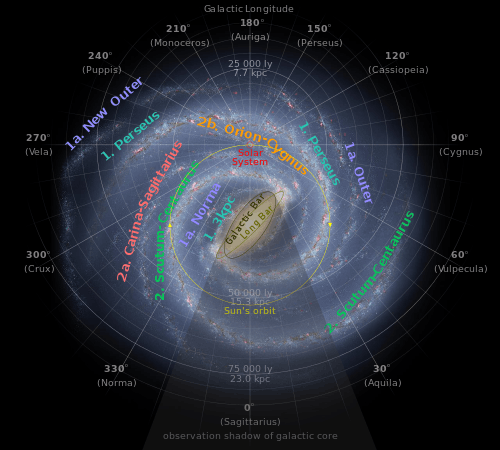Perseus Arm

The Perseus Arm is one of two major spiral arms of the Milky Way galaxy. The second major arm is called Scutum–Centaurus Arm. Perseus Arm begins from the distal end of the long Milky Way.[1] Previously thought to be 13000 light-years distant, it is now thought to lie 6400 light years from our Solar System.[2]
The Milky Way is a barred spiral galaxy with two major arms and a number of minor arms or spurs.[1] The Perseus Spiral Arm, with a radius of approximately 10.7 kiloparsecs, is located between the minor Cygnus and Carina–Sagittarius Arms.[1] It is named after the Perseus constellation in the direction of which it is seen from Earth.
There is speculation that the local spur known as the Orion–Cygnus Arm, which includes the Solar System and Earth and is located inside of Perseus Arm,[1] is a branch of it, but this is unconfirmed.
The Perseus Spiral arm contains a number of Messier objects:
- The Crab Nebula (M1)
- Open Cluster M36
- Open Cluster M37
- Open Cluster M38
- Open Cluster M52
- Open Cluster M103.
See also
References
- ↑ 1.0 1.1 1.2 1.3 Churchwell, Ed; Babler, Brian L.; Meade, Marlin A. (2009). "The Spitzer/GLIMPSE Surveys: A New View of the Milky Way" (PDF). Publications of the Astronomical Society of the Pacific 121: 213–230. Bibcode:2009PASP..121..213C. doi:10.1086/597811.
- ↑ McKee, Maggie (8 December 2005). "Spiral arm of Milky Way looms closer than thought". New Scientist. Reed Business Information Ltd. Retrieved 31 October 2013.
External links
| |||||||||||||||||||||||||||||||||||||||||||
